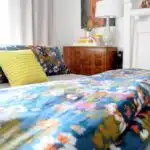Mold on a mattress is a common problem for many people, especially those who live in humid or damp environments. Not only can mold cause unpleasant odors and stains, but it can also have negative health effects, such as respiratory issues and allergies. As a professional house cleaner, I have encountered numerous cases of mold on mattresses and have developed effective methods for removing it.
In this article, I will provide you with practical tips on how to get rid of mold on your mattress through proper cleaning techniques. These tips are based on my years of experience as a house cleaner and are designed to help you maintain a clean and healthy sleeping environment. By following these steps, you can ensure that your mattress remains mold-free and that you get the restful sleep that you deserve.
Identifying Mold On Your Mattress
Like a silent thief, mold can invade your home and silently breed on your mattress. It is essential to identify the presence of mold early enough before it causes significant damage. Identifying moisture sources is crucial in detecting mold growth on your mattress. When you notice dampness or water stains on your mattress, it’s a sign of mold infestation. At times, the tell-tale signs may not be visible, and you might have to rely on your sense of smell to detect musty odors emanating from your bed.
Mold growth on your mattress poses serious health implications that should not be ignored. Prolonged exposure to mold spores can cause allergic reactions and respiratory problems such as wheezing, coughing, and shortness of breath. Individuals with pre-existing health conditions such as asthma are at higher risk of developing severe symptoms due to mold exposure. If left unchecked, the effects can be detrimental to one’s overall well-being.
Understanding the health risks of mold growth on your mattress is crucial in taking appropriate action towards eliminating it. The next section will highlight some effective cleaning methods that you can use to eradicate mold from your mattress.
Understanding The Health Risks Of Mold
After identifying mold on your mattress, it is important to understand the potential health effects that come with exposure to mold. Mold can cause respiratory problems, allergic reactions, and even infections. Those with weakened immune systems or pre-existing respiratory conditions are particularly vulnerable to these health risks. Therefore, it is essential to address any mold growth on your mattress promptly.
Prevention is key when it comes to mold growth on a mattress. To prevent mold from forming in the first place, keep your bedroom well-ventilated by allowing fresh air to circulate and by using a dehumidifier if necessary. Additionally, regularly washing your bedding and vacuuming your mattress can help eliminate any potential sources of moisture that could lead to mold growth.
If you do find mold on your mattress, there are steps you can take to clean and remove it safely. However, it is important to note that cleaning up mold can be hazardous and should be done carefully with proper protective gear. In the next section, we will discuss how to prepare your cleaning supplies and tools before beginning the process of removing mold from your mattress.
Preparing Your Cleaning Supplies
Did you know that the average person spends approximately one-third of their life sleeping? That’s a lot of time spent on your mattress, making it essential to keep it clean and free from mold. Before you begin cleaning your mattress, you need to prepare all the necessary cleaning supplies. This will help ensure that you have everything you need to get the job done quickly and effectively.
Choosing effective cleaning solutions is crucial when it comes to removing mold from your mattress. You’ll want to look for products that are specifically designed for mold removal as they contain active ingredients that target and kill mold spores. Additionally, be sure to read the labels carefully and follow all instructions for use. Protecting yourself during the cleaning process is also important, so wear gloves and a mask if possible.
To make the process more manageable, consider creating a checklist of all the things you’ll need before starting. Here are some essential items you should have on hand:
- Mold removal solution
- Clean, white towels
- Baking soda
- Vacuum cleaner with upholstery attachment
By having these items ready, you can streamline your cleaning process and avoid any last-minute trips to the store. Remember, preparation is key when it comes to keeping your home clean and healthy.
As you move forward with preparing your cleaning supplies, don’t forget about protecting yourself during this process by wearing gloves and a mask if possible. Once you’ve gathered everything together, it’s time to move onto our next step: removing bedding and other items from your mattress.
Removing Bedding And Other Items
- Stripping the bedding is the first step in the process of removing bedding and other items that may have become contaminated with mold.
- After stripping, bedding should be washed on the hottest water setting possible to kill the mold spores.
- It is important to use an appropriate detergent for the material being washed in order to ensure that the mold is effectively killed.
- After washing, the mattress should be thoroughly vacuumed to remove any remaining mold spores or debris.
- It is important to use a vacuum with a HEPA filter to ensure that all spores are properly removed from the surface of the mattress.
- All bedding and other items should be dried on the highest heat setting possible to prevent the growth of any remaining mold spores.
Strip Bedding
To effectively get rid of mold on your mattress, one of the first steps is to strip all bedding and other items from the bed. This means removing all sheets, pillowcases, blankets, and any other fabric that may be on or near the mattress. It is important to carefully remove each item so as not to spread any mold spores that may be present.
Once all bedding has been removed, it is important to follow specific washing instructions for each item. This may involve washing in hot water with a bleach solution or using a special mold-fighting laundry detergent. It is also recommended to use mattress protectors that are specifically designed to prevent mold growth. These protectors can be easily cleaned and help keep the mattress itself clean and dry.
Overall, stripping bedding is an essential step in getting rid of mold on your mattress. By following proper washing instructions and utilizing mattress protectors, you can help prevent future mold growth and ensure a clean sleeping environment. Remember to take extra care when handling items during this process in order to avoid spreading any potential mold spores.
Wash Bedding
After stripping all bedding and other items from the bed, the next step to effectively get rid of mold on your mattress is to wash all fabric items. It is important to determine the washing frequency of each item based on its material and level of contamination. For heavily contaminated items, it is recommended to use hot water and a mold-fighting laundry detergent. Additionally, for white or light-colored fabrics, bleach can be added to the washing solution.
When washing bedding and other fabric items, it is imperative to use appropriate drying techniques. Using high heat in a dryer can cause shrinkage and damage fabrics, so it is best to air dry them whenever possible. If using a dryer, select a low heat setting or use a tumble dry option with no heat. It is also important to ensure that all items are completely dry before putting them back on the bed to prevent any moisture buildup that can lead to future mold growth.
By properly washing and drying all bedding and other fabric items, you can prevent mold growth from reoccurring. Remember that regular cleaning of your bedding and mattress protectors can help reduce the risk of mold growth in the first place. Maintaining proper hygiene practices will not only keep your sleeping environment clean but also promote healthy sleep habits for a better quality of life.
Vacuum Mattress
To ensure proper mattress maintenance, it is important to not only clean the bedding and other fabric items but also vacuum the mattress. Vacuuming helps remove any dust or debris that may have accumulated on the surface of the mattress. This step also aids in preventing dust mites from settling and breeding within the fibers of your mattress.
When vacuuming your mattress, it is crucial to use a vacuum with a high-efficiency particulate air (HEPA) filter. This type of filter traps small particles such as dust mites and their feces, which can trigger allergies or asthma symptoms for some individuals. Additionally, it is recommended to use a crevice tool attachment to reach tight spaces along seams and edges where dust and other debris tend to accumulate.
Vacuuming your mattress should be done regularly as part of your cleaning routine. For those who suffer from allergies or asthma, it may be necessary to vacuum more frequently. By incorporating this step into your regular cleaning regimen, you can help prevent mold growth and maintain a clean sleep environment for a better night’s rest.
Vacuuming The Mattress Surface
After removing any visible mold from your mattress, it’s time to deep clean the surface to prevent recurring growth. One of the most effective ways to do this is by vacuuming the entire surface of the mattress. First, remove all bedding and vacuum both sides of the mattress thoroughly. This will remove any loose spores that may still be present.
For a more thorough cleaning, consider using professional services to get rid of mold on your mattress. These services use specialized equipment designed to kill and remove mold completely, preventing future growth. However, if you prefer to do it yourself, make sure to vacuum every inch of the mattress surface, paying special attention to seams and crevices where spores may hide.
Incorporating regular deep cleaning into your routine can help prevent mold growth on your mattress altogether. But if you do find mold on your mattress, vacuuming is an essential first step in getting rid of it. Once you have completed this step, you can move on to applying a cleaning solution that will eliminate any remaining spores and prevent them from coming back.
Applying A Cleaning Solution
After vacuuming the surface of the mattress, it’s time to apply a cleaning solution. This step is crucial in removing mold and preventing it from returning. There are two options for cleaning solutions: DIY or professional cleaning.
DIY cleaning solutions are cheaper and easy to make, using common household items such as vinegar, baking soda, or hydrogen peroxide. However, these solutions may not be effective in removing tough mold stains and odors. Professional cleaning services use specialized equipment and chemicals that guarantee complete removal of mold without damaging the mattress fabric and foam.
When applying a cleaning solution, it’s important to follow the instructions carefully to avoid any damage to your mattress. Use a spray bottle or damp cloth to apply the solution evenly on the affected area. Let it sit for several minutes before gently wiping it off with a clean cloth or sponge.
Transition into subsequent section about scrubbing the mattress surface: “After applying the cleaning solution, it’s now time to tackle stubborn mold stains by scrubbing the mattress surface.”
Scrubbing The Mattress Surface
- Before beginning the scrubbing process, it is essential to assess the type of mold present on the mattress surface and determine the best cleaning products for the job.
- To effectively scrub the mattress surface, it is necessary to gather the appropriate tools, such as a soft-bristled brush, cleaning solution, and a vacuum with a hose attachment.
- When cleaning the mattress, it is important to always avoid using abrasive materials, such as steel wool, and to avoid using heat or steam as this can damage the mattress upholstery.
- Additionally, it is important to always work in small sections, scrubbing the surface gently and then vacuuming the area to remove any residue.
Preparing To Scrub
Maintaining a clean and healthy sleeping area is essential for a good night’s sleep. One of the most common problems people face is mold growth on their mattresses. To get rid of mold, you need to scrub the mattress surface thoroughly. However, before you start scrubbing, it’s crucial to prepare your cleaning area and choose the right cleaning products.
To begin with, you should choose cleaning products that are safe and effective in removing mold stains from your mattress. You can use household items like baking soda or vinegar mixed with water to create a natural solution. Additionally, you can find specialized cleaners designed specifically for removing mold stains from fabrics. It’s important to read the labels carefully and follow the instructions for use.
Next, preparing your cleaning area is crucial as it ensures that you have everything you need at hand. Make sure you have enough space to work comfortably around the mattress, preferably in a well-ventilated room. Gather all necessary materials like cleaning products, rubber gloves, clean rags or sponges, and a bucket of warm water. By doing this beforehand, you’ll avoid any interruptions during the cleaning process and make it more efficient.
In conclusion, preparing to scrub your mattress surface is an essential step in getting rid of mold stains effectively. Choosing appropriate cleaning products and preparing your cleaning area will enable you to work efficiently towards achieving a clean and healthy sleeping environment. With these steps in mind, you’re now ready to proceed with scrubbing the mattress surface thoroughly.
Tools Needed
Maintaining a clean and healthy sleeping area requires regular cleaning, especially when dealing with mold growth on your mattress. Scrubbing the mattress surface is an effective way to remove mold stains, but it’s essential to have the right tools for the job. Cleaning tools are necessary for scrubbing the mattress surface thoroughly, and using DIY solutions can be helpful in removing mold stains effectively.
When preparing to scrub your mattress surface, you’ll need several cleaning tools such as a stiff-bristled brush, clean rags or sponges, rubber gloves, and a bucket of warm water. A stiff-bristled brush is ideal for scrubbing the affected areas without damaging the fabric of your mattress. Clean rags or sponges are useful in wiping away excess water after scrubbing while rubber gloves protect your hands from harmful chemicals in cleaning products.
DIY solutions like vinegar mixed with water or baking soda paste can be helpful in removing mold stains from your mattress. These solutions are safe to use and effective in removing stubborn stains without causing damage to your mattress’s fabric. Additionally, they’re affordable and readily available at home. By having these cleaning tools and DIY solutions ready before scrubbing your mattress surface, you’ll be able to achieve a clean and healthy sleeping environment effectively.
Rinsing And Drying The Mattress
Dousing the mattress with water is not enough to get rid of mold. The rinsing process is crucial in removing any remaining mold spores from the mattress surface. Remember that the longer the mold stays on your bed, the more it will spread and damage your health.
Air drying methods are an essential part of the cleaning process. After rinsing, use a dry cloth to absorb excess water from the mattress. Next, prop the mattress upright against a wall or lay it flat outside under direct sunlight for several hours. Sunlight is an excellent natural disinfectant that helps kill lingering bacteria.
Importance of proper ventilation cannot be overstated when drying mattresses. Ensure proper airflow by opening windows or turning on fans in your room to allow air to circulate around the bed. If you reside in a place where there’s no direct sunlight or low humidity levels, using an electric fan can help speed up the drying process without damaging your mattress fibers.
To prevent future mold growth, using a dehumidifier is necessary. This device helps regulate humidity levels in your home by removing excess moisture in the air, making it difficult for mold spores to survive and thrive in your living space. By keeping humidity levels below 60%, you’ll effectively control mold growth and improve indoor air quality in your home.
Using A Dehumidifier To Prevent Future Mold Growth
Maintaining optimal humidity levels in your home is the key to preventing future mold growth. Benefits of dehumidifiers include reducing moisture levels in the air, which leads to a decrease in mold and mildew growth. It can also help to improve indoor air quality, reduce odors, and prevent damage to furniture and other household items.
The ideal humidity levels for homes typically range between 30-50%. Anything above 60% can create an environment that is conducive to mold growth. Investing in a good quality dehumidifier is a smart move as it helps to regulate humidity levels by removing excess moisture from the air. This is especially important during humid months or if you live in an area that experiences high levels of rainfall.
In addition to using a dehumidifier, there are other steps you can take to prevent mold growth in your home. These include improving ventilation, fixing any leaks or water damage promptly, and keeping your home clean and dry. By implementing these measures along with investing in a dehumidifier, you can significantly reduce the risk of mold growth and improve the overall cleanliness of your living space.
To ensure that your home is completely free from mold, it’s essential to clean and disinfect other affected areas such as carpets, curtains, upholstery, walls, ceilings, and floors thoroughly. In the next section, we’ll explore effective cleaning techniques that will help get rid of any remaining traces of mold spores in these areas.
Cleaning And Disinfecting Other Affected Areas
Don’t forget to disinfect electronics and other household items that may have come into contact with mold. Use a damp cloth with a mixture of water and vinegar to wipe down surfaces, including remote controls, phones, laptops, and other gadgets. Be sure to unplug these devices before cleaning and avoid getting them too wet.
In addition to your mattress, mold can also grow in the grout between bathroom tiles. To clean mold in these areas, mix equal parts bleach and water in a spray bottle and apply generously to the affected areas. Let the solution sit for 10-15 minutes before scrubbing with a stiff-bristled brush. Rinse thoroughly with warm water and dry the area completely.
After completing all necessary cleaning and disinfecting tasks, it’s important to assess any damage that may have occurred as a result of the mold growth. If your bedding or linens are severely damaged or cannot be properly cleaned, it’s time to replace them. Don’t take chances when it comes to your health – investing in new bedding is worth it in the long run.
Replacing Damaged Bedding And Linens
Damaged bedding and linens can be a real hassle to deal with, especially when it’s time to replace or repair them. If you’re dealing with a damaged mattress, it’s critical to assess the extent of the damage before deciding whether or not to replace it. Some minor repairs may be possible if you have the right tools and expertise, but if the damage is extensive, buying new is often the most practical solution.
When deciding whether to replace or repair your bedding and linens, consider the cost of each option as well as their respective benefits. Repairing your mattress can save you money in the short term, but may not be worth it in the long run if the damage is severe enough that it compromises your sleep quality or comfort. On the other hand, investing in high-quality new bedding and linens can provide long-term benefits such as improved comfort, durability and hygiene.
If you do decide to buy new bedding and linens, take some time to research different options before making a purchase. Look for products that are made from high-quality materials that are durable yet comfortable. Additionally, consider factors such as size, color and style to ensure that your new bedding matches well with your existing decor. With a little bit of effort and planning, replacing your damaged bedding and linens can be a simple yet effective way to improve your sleep quality and overall wellbeing.
As part of maintaining good sleep hygiene, inspecting your mattress regularly is essential. Regular inspections help identify any potential issues early on so that they can be addressed before they become more serious problems. In addition to checking for signs of wear and tear on the surface of your mattress, inspecting underneath it regularly can also help identify any signs of mold growth or other forms of damage that may need attention from a professional cleaner or repair person. By staying proactive about maintaining healthy sleeping habits through regular inspections and appropriate cleaning measures when necessary, you can enjoy better sleep quality for years to come.
Inspecting Your Mattress Regularly
Mold can be a serious problem in the home and often grows on mattresses. Regular inspection of mattresses can help identify any potential signs of mold. Proper cleaning methods should be employed to remove any mold that is found, such as vacuuming, spot cleaning and steam cleaning. To prevent mold from occurring, mattresses should be kept in a dry and cool environment, and all spills should be immediately cleaned up. It is also important to avoid excessive moisture, as this can lead to mold growth. Additionally, dehumidifiers and air filters can help eliminate excess moisture and improve air quality.
Signs Of Mold
As a professional house cleaner, it is crucial to inspect your mattress regularly for signs of mold. The thought of mold growing in your bed can trigger disgust and discomfort. Mold thrives in damp environments, making it easy for it to grow on your mattress. Causes of mold growth on mattresses include spills, humidity, and poor ventilation. To prevent mold growth, ensure that your bedroom is adequately ventilated, and promptly clean up any spills or moisture on your mattress.
The health effects of sleeping on a moldy mattress can be severe. Inhalation of the mold spores can trigger allergies and cause respiratory problems such as coughing and wheezing. Prolonged exposure to mold can lead to serious health issues such as asthma attacks and even lung infections. If you suspect that there is mold on your mattress, take immediate action to avoid any adverse health implications.
To treat mold on your mattress effectively, start by cleaning the affected area with a mixture of white vinegar and water. Alternatively, you can use hydrogen peroxide or baking soda mixed with water. Ensure that the affected area is thoroughly dried after cleaning to prevent further growth of the mold. In severe cases where the mold has spread extensively or if you are experiencing any health issues associated with exposure to molds, seek professional help from a qualified cleaner who specializes in removing molds from homes.
In conclusion, regularly inspecting your mattress for signs of molds is essential for maintaining good hygiene and avoiding potential health risks associated with sleeping on a contaminated bed surface. Take preventive measures such as ensuring adequate ventilation in your room and promptly cleaning up any spillages or moisture on your mattress to avoid creating an ideal environment for molds to thrive. If you detect any signs of molds on your bed surface, act fast by cleaning up the affected area using recommended solutions or seeking help from certified professionals if necessary.
Proper Cleaning Methods
As a professional house cleaner, it is not enough to just inspect your mattress regularly for signs of mold. You also need to know the proper cleaning methods to effectively remove any unwanted molds on your bed surface. There are different ways to clean a moldy mattress, but the most effective ones include using vinegar, hydrogen peroxide, or baking soda mixed with water.
When using vinegar, mix one part white vinegar with two parts water and spray the solution on the affected area. Let it sit for about 30 minutes before wiping it off with a clean cloth. For hydrogen peroxide and baking soda solutions, mix them with water separately and apply them directly on the moldy spots. Again, let them sit for at least 30 minutes before wiping off the excess moisture.
In addition to knowing these cleaning methods, you should also follow prevention tips to avoid mold growth in the first place. These include keeping your bedroom well-ventilated by opening windows or using fans, avoiding eating or drinking in bed to prevent spills, and using mattress protectors that can be easily washed and dried. By following these simple steps, you can ensure that your mattress stays clean and healthy for a good night’s sleep.
Prevention Tips
In addition to knowing effective cleaning methods for removing mold from your mattress, it is essential to adopt some prevention tips. These habits will help keep your mattress clean and free from molds, ensuring that you have a good night’s sleep. One of the critical factors in preventing mold growth is moisture control. You should ensure that your bedroom is well-ventilated by opening windows or using fans. This way, the air can circulate freely, reducing the chances of dampness and mold growth.
Another important habit you should cultivate is avoiding eating or drinking in bed. When you do this, there is a higher chance of spills or crumbs getting into your mattress, which can lead to mold growth over time. Using a mattress protector that can be easily washed and dried also helps prevent mold growth. It creates an extra layer of protection for your mattress while keeping it clean and fresh.
By adopting these simple cleaning habits and prevention tips, you can maintain the cleanliness and hygiene of your mattress effectively. Regularly inspecting your mattress for signs of mold and using appropriate cleaning methods when necessary will keep it free from unwanted molds. Remember always to keep moisture under control, avoid eating or drinking in bed, and use a washable mattress protector for best results.
Tips For Preventing Mold Growth
Preventive measures are key to avoiding mold growth in your living spaces. One of the most important things you can do is maintain moisture control. Mold thrives in damp environments, so it is essential to keep your home dry and well-ventilated. Regularly checking for leaks, repairing any that you find, and ensuring proper ventilation will aid in preventing mold growth.
Another preventive measure you can take is regularly cleaning and disinfecting surfaces prone to mold growth. This includes bathrooms, kitchens, and any other areas with high levels of moisture. Using a solution of vinegar or bleach mixed with water can help kill any existing spores and prevent new ones from forming.
Finally, keeping a watchful eye on humidity levels in your home is crucial to preventing mold growth. Invest in a hygrometer to track humidity levels and ensure they remain below 60%. If necessary, use dehumidifiers to remove excess moisture from the air.
By taking these preventive measures, you can significantly reduce the likelihood of mold growth in your home. However, if you do notice signs of mold despite your best efforts at prevention, it may be time to call a professional cleaner who has experience dealing with this issue.
Knowing When To Call A Professional Cleaner
1.Mold infestations can become severe when left unchecked, and typically present with visible discoloration, musty odors, and dampness on the affected surface. 2.If the infestation is severe, it is important to contact a professional cleaner to ensure a thorough removal of the mold. 3.Professional cleaners are equipped with the proper tools and safety equipment to eliminate the mold, and will be able to perform the job more quickly and efficiently than the average homeowner. 4.Additionally, professional cleaners will be able to address any underlying causes of the mold growth, such as water damage or ventilation issues, to ensure that the mold does not return.
Signs Of A Severe Infestation
Mold prevention is essential in maintaining the cleanliness of your home. A mold-infested mattress can lead to various health hazards, including respiratory problems and allergies. It’s crucial to be aware of the signs of a severe infestation to determine when to call a professional cleaner.
One of the most apparent signs of a severe mold infestation is the presence of a strong, musty odor on your mattress. This odor indicates that there is a high concentration of mold spores in the air. Additionally, if you notice any visible black or green spots on your mattress, this could be a sign of an extreme mold problem. These spots may spread rapidly and trigger adverse health effects.
Another sign that you have a severe mold infestation on your mattress is experiencing allergic reactions such as coughing, sneezing, or skin irritation after sleeping. If you notice these symptoms regularly, it’s time to have your mattress cleaned by professionals. Remember that mold thrives in moist environments; therefore, if you live in an area with high humidity levels and inadequate ventilation, it’s crucial to take extra precautions.
In conclusion, ignoring the signs of severe mold infestation on your mattress can result in serious health issues for you and your family members. Mold prevention should be a top priority in maintaining good indoor air quality. If you suspect that your mattress has a severe infestation, do not hesitate to call professional cleaners who possess the right equipment and expertise to eliminate the problem effectively.
Calling A Professional Cleaner
When it comes to mold infestation on your mattress, it’s crucial to know when to call a professional cleaner. While some minor mold issues can be solved with DIY techniques, severe infestations require the expertise of professionals. Hiring a professional cleaner not only ensures that the problem is effectively eliminated but also prevents further damage to your mattress and saves you money in the long run.
When hiring a professional cleaner for mold removal from your mattress, there are several tips to consider. First, ensure that the company has experience in dealing with mold removal specifically from mattresses. Second, verify that they have the necessary licenses and certifications for cleaning hazardous substances such as mold. Thirdly, check their customer reviews and ratings to guarantee their reliability and quality of service.
Cost considerations are another aspect to keep in mind when hiring a professional cleaner for mold removal on your mattress. The cost of removing mold varies depending on several factors, such as the extent of infestation, size of your mattress, and location. However, it’s essential not to compromise quality over price as cheaper options may not eliminate the problem entirely or cause further damage to your mattress. Ultimately, investing in a professional cleaner for mold removal is worth it for maintaining good indoor air quality and preventing health hazards associated with mold infestations.
Maintaining A Clean And Healthy Sleeping Environment
Did you know that the average person spends roughly one-third of their life asleep? That’s a significant amount of time spent in bed, making it crucial to maintain a clean and healthy sleeping environment. Not only does a clean bed promote better sleep quality, but it also helps prevent the spread of germs and allergens.
One essential aspect of maintaining a clean sleeping environment is proper ventilation. Adequate airflow in your bedroom can help reduce humidity levels, preventing the growth of mold and mildew. Open windows or use fans to circulate air and keep your bedding dry. Additionally, investing in an air purifier can help filter out any harmful pollutants or allergens that may be lingering in the air.
When it comes to cleaning your mattress, choosing the right products is key. Avoid using harsh chemicals, which can damage fabrics and irritate your skin. Instead, opt for natural cleaning solutions like vinegar or baking soda mixed with water. These ingredients are effective at removing stains and odors without causing any harm to your mattress.
Remember, maintaining a clean sleeping environment isn’t just about keeping up appearances – it’s about prioritizing your health and well-being. By ensuring proper ventilation and choosing safe cleaning products, you can rest easy knowing that you’re creating a sanctuary for yourself each night.
Conclusion
Mold on a mattress can pose serious health risks, and it is important to take action promptly to get rid of it. To begin with, you must identify mold on your mattress and gather the necessary cleaning supplies. Remove bedding and other items from the mattress before vacuuming the surface thoroughly. Regular inspections are vital for early detection of mold growth.
Preventing mold growth requires keeping your sleeping environment clean and dry. Ensure proper ventilation and use a dehumidifier if necessary. While it is possible to clean mold on your own, do not hesitate to call a professional cleaner if you are unsure or if the infestation is severe. Maintaining a clean and healthy sleeping environment should be an ongoing priority for everyone’s well-being.
In conclusion, getting rid of mold on your mattress requires prompt action and regular maintenance of a clean sleeping environment. Understanding the health risks associated with mold infestations is crucial in preventing potential harm. By following these cleaning tips and prevention strategies, you can ensure that your bed remains safe, healthy, and comfortable for years to come. Remember that prevention is always better than cure in maintaining a clean home free from unwanted intruders such as molds that can cause harm to you and your family.
Image Credits
- “Used Mattress” by silverfuture (featured)

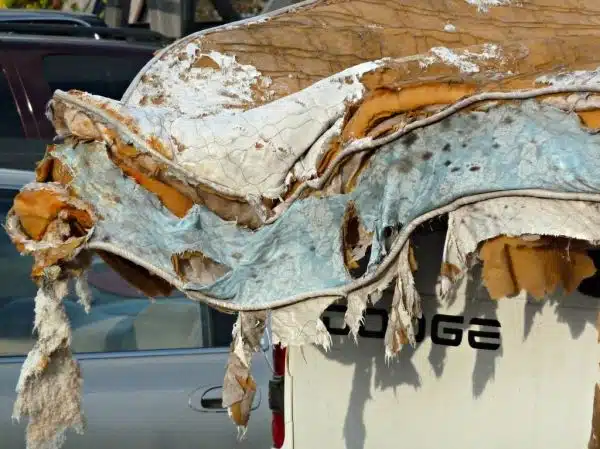




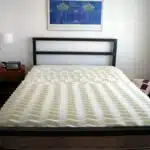






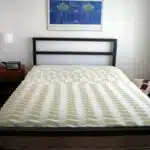


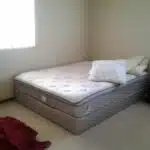







![How To Keep Sheets On A Bed: 10 Strategies 24 Bed sheets [Explored 2013-04-27]](https://green-life.blog/wp-content/uploads/2023/04/pH7FwL8jspjq-150x150.jpg.webp)




